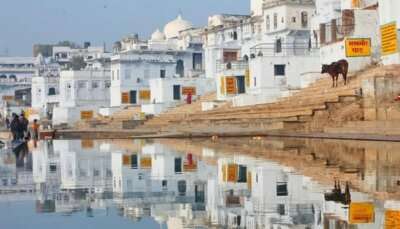St Cajetan Church Is A Must Have Experience To Remember In 2025
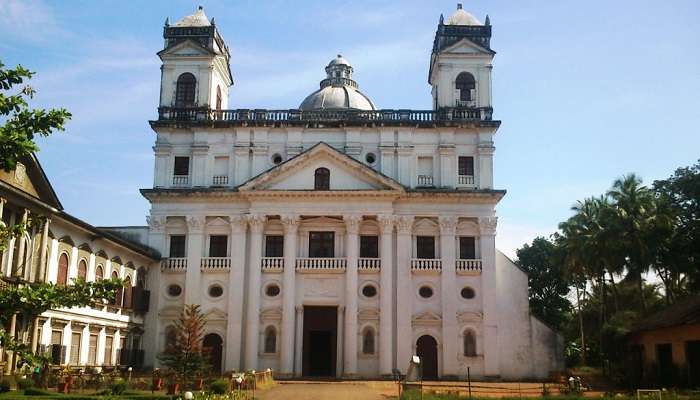
The St Cajetan Church, also known as the Church of Divine Providence, is a church of the Roman Catholic Archdiocese of Goa and Daman located in Old Goa. The church was completed in 1661 and is part of the World Heritage Site, Churches and convents of Goa. Although the church altar is dedicated to Our Lady of Divine Providence, the church is named after the founder of the Theatine order. We’ve compiled a list of all you need to know about the place when you decide to pay for your next visit to the beautiful city of Goa.
About St Cajetan Church
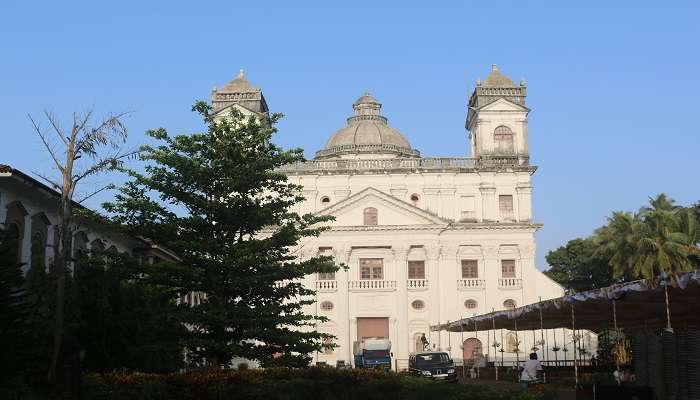
The large and beautiful Church of St. Cajetan lies about half a kilometre away to the northeast of the Se Cathedral and quite near the ruins of the Vice Regal Palace. This church, which is said to have been modelled on the original design of the Basilica of St. Peter in Rome, is architecturally Corinthian externally and internally, while the gilded altars with rich carvings are in rich Baroque style. The Church building itself is built of laterite blocks, which are lime-plastered. The Church of St. Cajetan, as it is popularly known (originally called The Church of Our Lady of Divine Providence) and the Convent of St. Cajetan were built by Italian friars of the Order of Theatines (known in Portuguese as Clérigos Regulares da Divina Providência). Although the church altar is dedicated to Our Lady of Divine Providence, the church is named after the founder of the Theatine order, St. Cajetan, a contemporary of St Francis Xavier. In 1639, Pope Urban VIII sent three Italians of the Order of Theatines to the kingdom of Golconda (near Hyderabad) to preach Christianity. They were D. Pedro Avitabili, D. Francisco Marci and D. Antonio Maria Ardizone. The friars were not permitted to work in Golconda, so they came to Goa on 25th October 1640.
In their new abode, they began the construction of a hospital, but the local Viceroy stopped their activities in 1643 and asked them to leave Goa in 1645. However, D. Pedro Avitabili, their courageous leader, went to Portugal to explain to the King, Dom João IV, that it would be in the interest of the Christian religion if they were allowed to work in Goa with the Portuguese priests. Impressed by the determination of the Italian friar, the King permitted the hospital’s building in 1650. In 1655, the Theatines obtained permission to build the Church and a Convent. The construction of the Church was completed in 1661. Although built around the same time, the Convent was much smaller and enlarged only later.
Must Read: Talpona Beach
Architecture
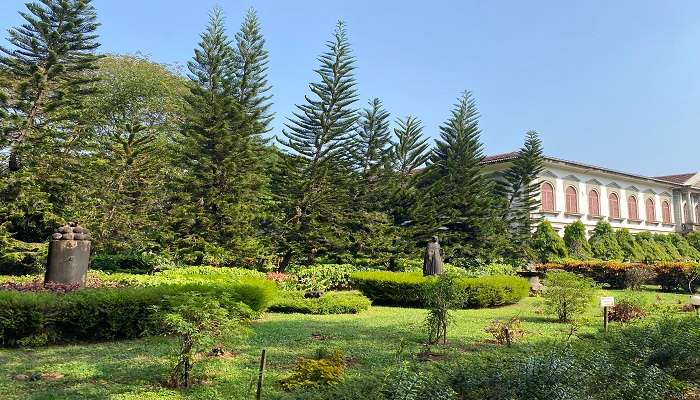
As the last remaining specimen of Italian architecture in Portuguese-held Goa, the church is unique in many ways. Crowned with a massive hemispherical dome modelled after St. Peter’s Basilica in Rome, the church displays two quadrangular turrets instead of towers. Ornate Corinthian columns adorn the frontispiece of the church, with four decorative niches containing the statues of the apostles Peter, Paul, John, and Matthew carved into the facade. Laid out in the shape of a Greek cross, the church’s interior is a play of contrasts between its pristine white walls and the dark statues carved in stone. The Theatine motto from Matthew 6:33, “Seek ye first the Kingdom of God, and all these things shall be added unto you,” is inscribed around the dome in Latin.
Another unusual feature of the church is a 72-foot-deep well located directly beneath the dome and marked by a raised square platform. If you peer through the opening, you can see the light from the windows set around the dome reflected on the water’s surface. The main altar, intricately carved and backed by a gilded reredos (an ornamental screen), is dedicated to Our Lady of Divine Providence. The church has six additional altars, including one dedicated to Saint Cajetan. The luminous walls are furnished with paintings that depict scenes from the saint’s life. The adjoining Convent of St. Cajetan, built on a much smaller scale than the church, is still quite impressive. It houses the Pius X Institute of Pastoral Theology to train priests and a small museum of Christian relics.
Interior Of St. Cajetan Church
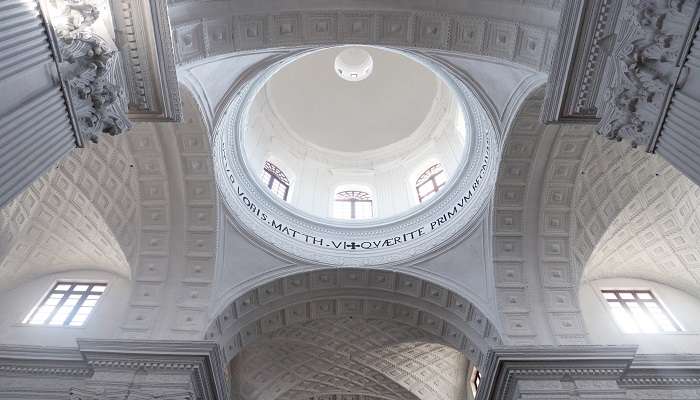
The interior of this church, whilst also Corinthian, shows Baroque, Rococo and Goan influences in the intricately carved and gilded work. Eight columns divide the church into a nave with six vaulted lateral chapels. The main altar is dedicated to Our Lady of Divine Providence, the patroness of the church. Underneath the altar is a crypt with a vault resting on four pillars. There are also six more altars, three on each side of the main one. Beneath the dome is a 22-meter-deep well devised by Fr. Francisco Manco, the architect, to provide an outlet for the waters oozing out of the subsoil, which had caused the walls to collapse twice.
As you enter the church, two fonts contain holy water, which once stood in the cathedral. The story goes that Cosimo III, Duke of Tuscany, donated Carrara marble fonts for holy water to this church, but these were later removed from the cathedral. The church is laid out as a Greek cross, although it appears oblong from the exterior. The main altar is profusely carved and backed by gilded reredos. This reredos is unique in that unlike most of the others seen in Goa, it tapers towards the ceiling and is crowned by a sun. The main altar is dedicated to Our Lady of Divine Providence. There is a statue of the Nossa Senhora da Divina Providência seated within the reredos holding a host and chalice.
Suggested Read: Romantic Resorts In Goa
How To Reach
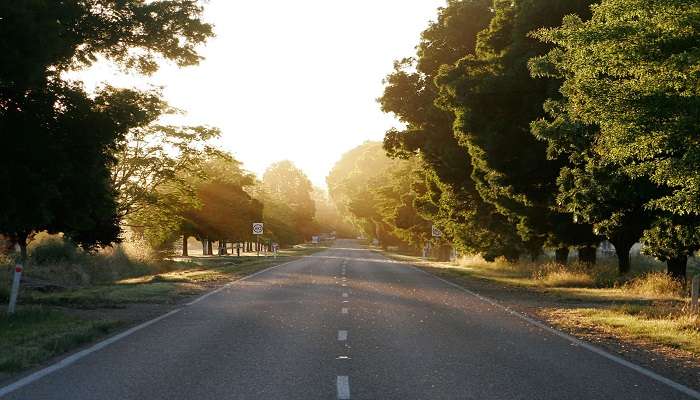
The Church of Cajetan is located in Velha Goa, close to the Mandovi River. There are multiple ways to arrive here:
By Air: The Dabolim Airport and the newly opened Manohar International Airport in North Goa are around an hour’s journey away, the latter being closer to the church. You can fly into either of the international airports in Goa. After arriving at the airport, you can hire a private cab from top car rental companies in Goa to reach the church.
By Train: If travelling by train, alight at the Madgaon Railway Station in Goa, which is around 40 km away from the Church of St. Cajetan.
By Bus: If you are arriving in Goa by bus, the Panaji KTC Bus Stand is only 10 km away from the church. It takes less than 20 minutes to reach by cab or 30 minutes by bus. You can also take a connecting local bus to Old Goa, which is hardly a 10-minute walk from the church.
By Bike or Scooty: Goa is famous for its bikes and scooters, which are available for rent. This mode of transport is flexible and helps you avoid traffic jams, as you can manoeuvre your way around.
Further Read: Hidden Places In Goa
Now that you have a list of things to remember for your next vacation to see the beautiful St Cajetan Church make sure you plan your trip to Goa to these fabulous spots for the experience of a lifetime. Don’t miss out on these opportunities, and book your tickets now!
For our editorial codes of conduct and copyright disclaimer, please click here.
Cover Image Credit: Goaforholidays for Wikimedia Commons
Frequently Asked Questions About St Cajetan Church
Where is St. Cajetan Church located?
St. Cajetan Church is situated in Old Goa, about 10 kilometres east of Panaji, the capital city of Goa, India. It's part of the UNESCO World Heritage Site of Churches and Convents of Goa.
When was St. Cajetan Church built?
The church was constructed between 1655 and 1661 by Italian friars of the Theatine order. It's dedicated to Our Lady of Divine Providence
What's unique about the architecture of St. Cajetan Church?
The church is renowned for its Corinthian architecture and is modeled after St. Peter's Basilica in Rome. It features a massive central dome, four mini domes, and ornate altars. The façade has two towers on either side, serving as belfries.
Is St. Cajetan Church still active for worship?
While no longer a regular parish church, it's maintained as a monument and occasionally hosts special religious services and events.
What are the visiting hours for St. Cajetan Church?
The church is typically open to visitors from 9:00 AM to 5:30 PM daily. However, it's always best to check current timings before visiting, as they may change during festivals or for maintenance work.
People Also Read:
Holy Trinity Churches Holy Rosary Church St Francis Xavier’s Church

Innovative Content Writer Focused on Producing High quality, Original Content that drives traffic and engages readers. Experienced in Content strategy and analytics to measure content performance using tools such as SQL, Power BI, Excel.



